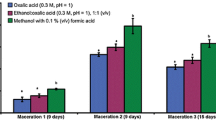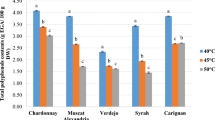Abstract
Grape pomace, leaves and canes generated by the wine industry are excellent and valuable resources to recover polyphenolic compounds with strong antioxidant capacity. Hence, the main objective of this work was to study the extraction process and the quality of grape juices enriched in the phenolic compounds extracted from grape skins, seeds and flesh, autumn leaves and canes of the Vitis vinifera species, cvs. País and Lachryma Christi. Thermomaceration of a mixture of grape must and pomace (8:1 w/w) at 60 °C resulted in a higher extraction degree of polyphenols, compared to maceration with pectolytic enzymes commonly used in enology. However, extraction modified pH and acidity of grape musts affecting anthocyanin contents of the samples. Generally, musts enriched by vine leaves and grape pomace of the Lachryma Christi cultivar showed the highest antioxidant properties, where must mashed on skins with seeds resulted into maximum total polyphenol contents of 2855 mg/L of gallic acid equivalents and must in contact with leaves yielded maximum antioxidant capacity of 93.5 mmol/L of Trolox equivalents. The juices using grape pomace were rich in anthocyanins (malvidin-3-glucoside) and flavan-3-ols (catechin and epicatechin); flavonols (quercetin-3-glucoside) and phenolic acids (caftaric and coutaric acid) were the main compounds in leaf extracts. Thermomaceration using grape pomace and vine leaves is preferred in order to achieve a grape must with a high amount of polyphenolics and antioxidants.




Similar content being viewed by others
References
Agati G, Azzarello E, Pollastri S, Tattini M (2012) Flavonoids as antioxidants in plants: location and functional significance. Plant Sci 196:67–76
Ferrer-Gallego R, Hernández-Hierro J, Rivas-Gonzalo J, Escribano-Bailón M (2012) Influence of climatic conditions on the phenolic composition of Vitis vinifera L. cv. Graciano. Anal Chim Acta 732:73–77
Obreque-Slier E, Peña-Neira A, López-Solís R, Cáceres-Mella A, Toledo-Araya H, López-Rivera A (2013) Phenolic composition of skins from four Carmenere grape varieties (Vitis vinifera L.) during ripening. LWT–Food. Sci Technol 54:404–413
Castillo-Muñoz N, Fernández-González M, Gómez-Alonso S, García-Romero E, Hermosín-Gutiérrez I (2009) Red-color related phenolic composition of Garnacha Tintorera (Vitis vinifera L.) grapes and red wines. J Agric Food Chem 57:7883–7891
Figueiredo-González M, Cancho-Grande B, Simal-Gándara J (2013) Garnacha Tintorera-based sweet wines: Chromatic properties and global phenolic composition by means of UV–Vis spectrophotometry. Food Chem 140:217–224
Río S, Pace C, Torchio F, Giacosa S, Gerbi V, Rolle L (2015) Impact of maceration enzymes on skin softening and relationship with anthocyanin extraction in wine grapes with different anthocyanin profiles. Food Res Int 71:50–57
Katalinić V, Generalić I, Skroza D, Ljubenkov I, Teskera A, Konta I, Boban M (2009) Insight in the phenolic composition and antioxidative properties of Vitis vinifera leaves extracts. Croatian J Food Sci Technol 1:7–15
Fernandes F, Ramalhosa E, Pires P, Verdial J, Valentão P, Andrade P, Bento A, Pereira JA (2013) Vitis vinifera leaves towards bioactivity. Ind Crop Prod 43:434–440
Orhan N, Aslan M, Orhan DD, Ergun F, Yesilada E (2006) In vivo assessment of antidiabetic and antioxidant activities of grapeleaves (Vitis vinifera) in diabetic rats. J Ethnopharmacol 108:280–286
Dani C, Oliboni LS, Agostini F, Funchal C, Serafini L, Henriques JA, Salvador M (2010) Phenol content of grapevine leaves (Vitis labrusca var. Bordo) and its neuroprotective effect against peroxide damage. Toxicol Vitro 24:148–153
Rabe E, Stücker M, Esperester A, Schäfer E, Ottillinger B (2011) Efficacy and tolerability of a red-vine-leaf extract in patients suffering from chronic venous insufficiency results of a double-blind placebo-controlled study. Eur J Vasc Endovasc Surg 41:540–547
Karvela E, Makris DP, Kalogeropoulos N, Karathanos V (2009) Deployment of response surface methodology to optimise recovery of grape (Vitis vinifera) stem polyphenols. Talanta 79:1311–1321
Apostolou A, Stagos D, Galitsiou E, Spyrou A, Haroutounian S, Portesis N, Trizoglou I, Wallace Hayes A, Tsatsakis AM, Kouretas D (2013) Assessment of polyphenolic content, antioxidant activity, protection against ROS-induced DNA damage and anticancer activity of Vitis vinifera stem extracts. Food Chem Toxicol 61:60–68
Bordeu E, Scarpa J (2000) Análisis químico del vino. Ediciones Universidad Católica de Chile, Santiago
Singleton V, Orthofer R, Lamuela-Raventós R (1999) Analysis of total phenols and other oxidation substrates and antioxidants by means of Folin-Ciocalteu reagent. Method Enzymol 299:152–178
Lee J, Durst R, Wrolstad R (2005) Determination of total monomeric anthocyanin pigment content of fruit juices, beverages, natural colorants, and wines by the pH differential method: collaborative study. J AOAC Int 88:1269–1278
Zhishen J, Mengcheng T, Jianming W (1999) The determination of flavonoid contents in mulberry and their scavenging effects on superoxide radicals. Food Chem 64:555–559
Rebolo-López S (2007) Estudio de la composición polifenólica de vinos tintos gallegos con D.O.: Ribeiro, Valdeorras y Ribeira Sacra. Universidad de Santiago de Compostela, Lugo
Castillo-Muñoz N, Gómez-Alonso S, García-Romero E, Hermosín-Gutiérrez I (2007) Flavonol profiles of Vitis vinifera red grapes and their single-cultivar wines. J Agric Food Chem 55:992–1002
OIV (2007) HPLC-Determination of nine major anthocyanins in red and rosé wine (Resolution Oeno 22/2003 modified by Oeno 12/2007). Compendium of international methods of analysis-OIV anthocyanins, OIV-MA-AS315-11, pp 1–13
Ruiz A, Mardones C, Vergara C, Hermosín-Gutiérrez I, von Baer D, Hinrichsen P, Rodríguez R, Arribillaga D, Dominguez E (2013) Analysis of hydroxycinnamic acids derivatives in calafate (Berberis microphylla G. Forst) berries by liquid chromatography with photodiode array and mass spectrometry detection. J Chromatogr A 1281:38–45
Gorena T, Saez V, Mardones C, Vergara C, Winterhalter P, von Baer D (2014) Influence of post-pruning storage on stilbenoid levels in Vitis vinifera L. canes. Food Chem 155:256–263
Mullen W, Marks SC, Crozier A (2007) Evaluation of phenolic compounds in commercial fruit juices and fruit drinks. J Agric Food Chem 55:3148–3157
Borges G, Mullen W, Crozier A (2010) Comparison of the polyphenolic composition and antioxidant activity of European commercial fruit juices. Food Funct 1:73–83
Lutz M, Cajas Y, Henríquez C (2012) Phenolics contents and antioxidant capacity of Chilean grapes cv. País and Cabernet Sauvignon. CyTA J Food 10:251–257
Chamorro S, Goñi I, Viveros A, Hervert-Hernández D, Brenes A (2012) Changes in polyphenolic content and antioxidant activity after thermal treatments of grape seed extract and grape pomace. Eur Food Res Technol 234:147–155
Sólyom K, Solá R, Cocero MJ, Mato RB (2014) Thermal degradation of grape marc polyphenols. Food Chem 159:361–366
Martino KG, Paul MS, Pegg RB, Kerr WL (2013) Effect of time–temperature conditions and clarification on the total phenolics and antioxidant constituents of muscadine grape juice. LWT Food Sci Technol 53:327–330
Romero-Cascales I, Fernández-Fernández JI, Ros-García JM, López-Roca JM, Gómez-Plaza E (2008) Characterisation of the main enzymatic activities present in six commercial macerating enzymes and their effects on extracting color during winemaking of Monastrell grapes. Int J Food Sci Technol 43:1295–1305
Ribéreau-Gayon P, Glories Y, Maujean A, Dubourdieu D (2006) Handbook of enology, Vol 2. The chemistry of wine stabilization and treatments, 2nd edn. Wiley, London
Gil G, Pszczolkowski P (2007) VitiCultura. Fundamentos para optimizar producción y calidad. Ediciones Universidad Católica de Chile, Santiago
Bermúdez-Soto MJ, Tomás-Barberán FA (2004) Evaluation of commercial red fruit juice concentrates as ingredients for antioxidant functional juices. Eur Food Res Technol 219:133–141
Sacchi KL, Bisson LF, Adams DO (2005) A review of the effect of winemaking techniques on phenolic extraction in red wines. Am J Enol Vitic 56:197–206
Brouillard R, Wigand M, Dangles O, Cheminat A (1991) PH and solvent effects on the copigmentation reaction of malvin with polyphenols, purine and pyrimidine derivatives. J Chem Soc Perkin Trans 2:1235–1241
Lapidot T, Harel S, Akiri B, Granit R, Kanner J (1999) PH-dependent forms of red wine anthocyanins as antioxidants. J Agric Food Chem 47:67–70
Monagas M, Bartolomé B, Gómez-Cordovés C (2005) Updated knowledge about the presence of phenolic compounds in wine. Crit Rev Food Sci Nutr 45:85–118
Hillmann M, Burin V, Bordignon-Luiz M (2011) Thermal degradation kinetics of anthocyanins in grape juice and concentrate. Int J Food Sci Technol 46:1997–2000
Sui X, Dong X, Zhou W (2014) Combined effect of pH and high temperature on the stability and antioxidant capacity of two anthocyanins in aqueous solution. Food Chem 163:163–170
Castillo-Muñoz N, Gómez-Alonso S, García-Romero E, Gómez MV, Velders AH, Hermosín-Gutiérrez I (2009) Flavonol 3-O-glycosides series of Vitis vinifera cv. Petit Verdot red wine grapes. J Agric Food Chem 57:209–219
Morel-Salmi C, Souquet J, Bes M, Cheynier V (2006) Effect of flash release treatment on phenolic extraction and wine composition. J Agric Food Chem 54:4270–4276
Castillo-Muñoz N, Gómez-Alonso S, García-Romero E, Hermosín-Gutiérrez I (2010) Flavonol profiles of Vitis vinifera white grape cultivars. J Food Compos Anal 23:699–705
Monagas M, Hernández-Ledesma B, Gómez-Cordovés C, Bartolomé B (2006) Commercial dietary ingredients from Vitis vinífera L. leaves and grape skins: antioxidant and chemical characterization. J Agric Food Chem 54:319–327
Lima M, Silani I, Toaldo I, Corrêa L, Telles Biasoto A, Pereira G, Bordignon-Luiz MT, Ninow JL (2014) Phenolic compounds, organic acids and antioxidant activity of grape juices produced from new Brazilian varieties planted in the Northeast Region of Brazil. Food Chem 161:94–103
Moreno-Montoro M, Olalla-Herrera M, Gimenez-Martinez R, Navarro-Alarcon M, Rufián-Henares J (2015) Phenolic compounds and antioxidant activity of spanish commercial grape juices. J Food Compos Anal 38:19–26
Fernández K, Labra J (2013) Simulated digestion of proanthocyanidins in grape skin and seed extracts and the effects of digestion on the angiotensin I-converting enzyme (ACE) inhibitory activity. Food Chem 139:196–202
Amalfitano C, Agrelli D, Arrigo A, Mugnai L, Surico G, Evidente A (2011) Stilbene polyphenols in the brown red wood of Vitis vinifera cv. Sangiovese affected by “esca proper”. Phytopathol Mediterr 50:S224–S235
Vergara C, von Baer D, Mardones C, Wilkens A, Wernekinck K, Damm A (2011) Stilbene levels in grape cane of different cultivars in southern Chile: determination by HPLC–DAD–MS/MS method. J Agric Food Chem 60:929–933
Likhtenshtein G (2010) Stilbenes. Applications in chemistry, life sciences and material science. Wiley, Weinheim
Ali K, Maltese F, Hae Choi Y, Verpoorte R (2010) Metabolic constituents of grapevine and grape-derived products. Phytochem Rev 9:357–378
Gómez-Gallego MA, Gómez García-Carpintero E, Sánchez-Palomo E, Hermosín-Gutiérrez I, González-Viñas MA (2012) Study of phenolic composition and sensory properties of red grape varieties in danger of extinction from the Spanish region of Castillo–La Mancha. Eur Food Res Technol 234:295–303
Acknowledgments
The authors would like to thank Viña Zamora for providing grape samples, and the National Commission for Scientific and Technological Research (FONDEF VIU 120010) and the Chilean Ministry of Education (CD UCO 1201) for financial support.
Author information
Authors and Affiliations
Corresponding author
Ethics declarations
Conflict of interest
The authors declare that they have no conflict of interest.
Ethical standards
This article does not contain any studies with human or animal subjects.
Rights and permissions
About this article
Cite this article
Aguilar, T., Loyola, C., de Bruijn, J. et al. Effect of thermomaceration and enzymatic maceration on phenolic compounds of grape must enriched by grape pomace, vine leaves and canes. Eur Food Res Technol 242, 1149–1158 (2016). https://doi.org/10.1007/s00217-015-2619-3
Received:
Revised:
Accepted:
Published:
Issue Date:
DOI: https://doi.org/10.1007/s00217-015-2619-3




